
この現実のむこうに―Here and Beyond
10月28日(土)-12月10日(日)10:00-18:00 会期中無休/無料
ラーキー・ペスワニ
Rakhi PESWANI
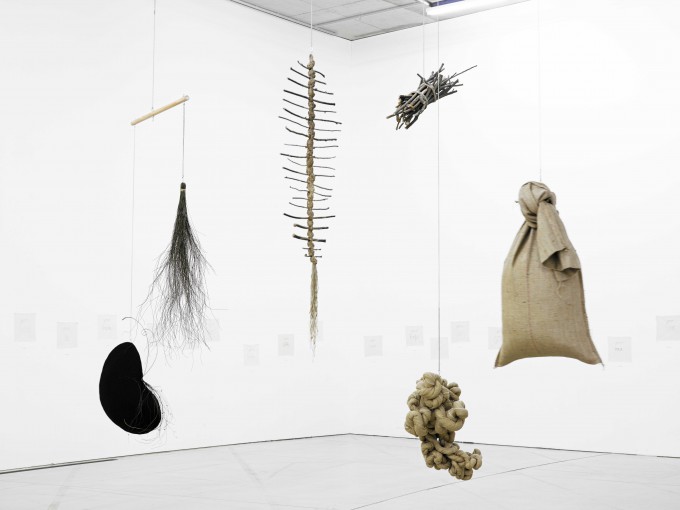
《初まりの合図(あやふやなバランス)》
木、黄麻布、鉄、紙、サイズ可変、2017年
撮影:山本糾
価値観のルーツへ
村上 綾
ペスワニは、会場の壁面に刺繍の作品《初まりの合図(私たちの体)》、テーブルには複数の虫の絵をポストカードに描いた《初まりの合図(無垢の体験)》、天井からはモビールである《初まりの合図(あやふやなバランス)》を吊り、タイトルからも明らかなようにそれらはそれぞれに独立した作品でありながらも密なつながりを持たせて構成した。
《初まりの合図(私たちの体)》は壁に貼られた30枚ほどの綿布からなり、それぞれに感覚にかかわる言葉の上に「your (あなたの)」と刺繍され、見る人に自身の身体感覚について考えさせる。刺繍された言葉は、「Itch(かゆみ、うずうずする気持ち)」など、肉体が受ける感覚だけでなく、精神的な状況も表す言葉が並んだ。また、揺らいだ線で刺繍された「Angry」は怒りに震えるような身体を思わせ、小さく布の端にひっそりと存在し、そのまま布から消えていってしまいそうな「Silence」は、はっと言葉を飲み込むときの感覚も想起させる。意識されにくい重層的な私たちの感情や感覚を、細やかな刺繍で表現してみせた。それは、肉体と精神からなる私たちの身体感覚を丁寧に解きほぐし、いかに私たちが肉体と精神でもって刺激を受ける外界と関係を結んでいるのか、諭し伝えるようである。
《初まりの合図(無垢の体験)》の鑑賞は、家でくつろぐときのように靴を脱いで、テーブルの上に広がるたくさんのカードを見ることから始まる。繊細な筆致で描かれた虫の絵を眺め、山折りになったカードを開いて書かれた文字を読むとき、小さな命に触れるときのように、おそるおそる手に取り、丹念にながめる。その行為は、幼いころ、名も知らぬ虫を手のひらに載せて観察していたように、周りの環境に真摯に向き合っていたときのことを思い起こさせるだろう。緻密に描かれた虫たちは、そのときの初々しくも貪欲な観察力を示唆し、いかに私たちが肉体と精神とで刺激を受ける外界に反応し、それらと関係性を築いてきたかを思い出させるのである。
《初まりの合図(あやふやなバランス)》は6つのオブジェクトで構成されている。ねじられた黄麻布、木の枝の束、豆のような形をしたクッション、動物の骨や葉の形を思わせる木のオブジェ、おおきく膨らんだ黄麻袋。どれか一つに触れれば、他の物も合わせてゆれ動き、空間全体の見え方が変化していく楽しさがある。先に述べた2つの作品では、鑑賞者の記憶を通して身体感覚が呼び起されることに特徴があったが、この作品では、より直接的に身体感覚が刺激されるだろう。どれか一つのオブジェを観察するためであったり、モビール全体の動きを見るためであったり、あるいはどれかを触るためであったり、鑑賞者は自然と作品に合わせて体を動かし、視覚や触覚から呼び起される印象も変化し続ける。また、ここにはイギリスの植民地時代以降の近代化したインドの風景も重ねられている。
ペスワニは今までも、視覚や嗅覚から得られる印象によって、労働や社会環境を想起させる作品を制作してきた。例えば《労働者の実(消耗のモニュメント)》[fig.1]で使用したコーヒーや紅茶の出し殻は、しずく型にぶら下がった綿モスリンの袋の中からシミを作り、しだいに匂いを放ち始める。出稼ぎ労働者が膨らんだ袋を持ってバスに乗っているのはインドでは日常風景だという。そのため袋は労働者を、そこにできたシミはその汗を示している。奥の壁に配置されたドローイングを見に行くには、その袋の群衆を通り抜けねばならず、通勤のために車内でひしめき合う人のなかで、汗の匂いも感じながら分け入って進む体験を思い出すようになっていた(*1)。
今回制作された《初まりの合図(あやふやなバランス)》においても、大きく膨らんだ袋は労働者を思わせる。その他、ねじられた一本の黄麻布は人のエネルギーを、豆の形のクッションから針金が伸びたオブジェは植物の芽吹きを、骨のようなオブジェは生き物を、木の束はインドでよく使われる燃料である薪を表し、人が移動しながら生活をする現代において、関連しあっている他の物事も動き、連鎖していく様子を表している。
このように、ペスワニの作品は、周りの世界と私たちとの関係性がいかに築かれ、連環しているか、私たちに諭し伝える。これら一連の作品は、見る人を、周りの世界に私たち自身を合わせるという基本的な価値観に立ち返らせるのである。
____________________________________________
(*1)関連イベントのトークでの発言(2017年11月12日)。
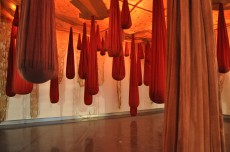
fig.1
《労働者の実(消耗のモニュメント)》Zhejiang Art Museum(中国)での展示、2013年

《初まりの合図(あやふやなバランス)》
木、黄麻布、鉄、紙、サイズ可変、2017年
撮影:山本糾
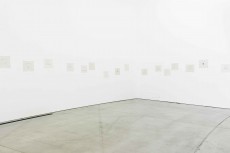
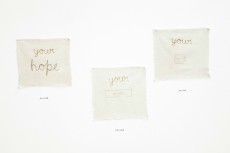
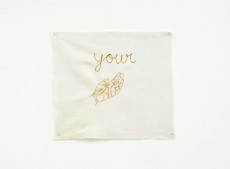

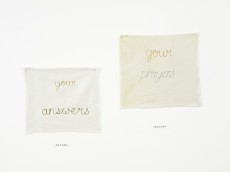
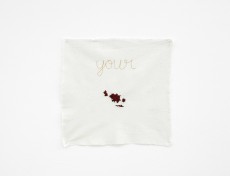
《初まりの合図(私たちの体)》
キャラココットンに刺繍、虫ピン、サイズ可変
2017年
撮影:山本糾
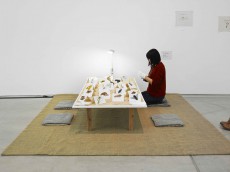

《初まりの合図(無垢の経験)》
中性紙にガッシュと鉛筆、閲覧机、サイズ可変
2017年
撮影:山本糾
Here and Beyond
10:00am - 6:00pm,October 28 - December 10, 2017 / Admission Free
[wp-blogro11 catname=air2017-5en orderby=ur1]
Rakhi PESWANI

Primal Reminders (The Precarious Balance)
wood, burlap, wool, iron, paper, size variable, 2017.
photo: YAMAMOTO Tadasu
MURAKAMI Aya
Rakhi PESWANI produced a series of independent yet closely related artworks for her exhibition, something clearly illustrated by the titles of each piece. Primal Reminders (Our Bodies), a work of embroidery, hung on several walls of the exhibition hall. Primal Reminders (Experience of Innocence), which depicts multiple insects on postcards, sat on a table in the space. Her third piece, Primal Reminders (A Precarious Balance), a mobile, hung from the ceiling.
Primal Reminders (Our Bodies) consists of about 30 pieces of cotton affixed to the wall, each embroidered with the word "your" followed by a descriptive feeling, inviting the viewer to reflect on different bodily sensations. The embroidered words, such as “itch,” comprised a collection of both physical and mental sensations. “Angry” is embroidered in shaky lines reminiscent of a body trembling with rage, while “silence,” which sits quietly in a corner of the cloth as if waiting to disappear, evokes the sensation of holding one’s tongue. Peswani’s intricate embroidery shows us multilayered emotions and sensations that we have a hard time recognizing on our own. They unravel our bodily sensations, both mental and physical, and convey just how linked we are to our outside world, which constantly stimulates our minds and bodies.
To look at Primal Reminders (Experience of Innocence), you first take off your shoes and sit at a low table, much like you may if you were relaxing at home. Spread across the table are an array of cards that bear the likeness of various insects. When you look upon the insects, each drawn with delicate brushstrokes, and open the top-fold cards to read what is written inside, you do so as if handling a small life, gingerly taking it in your hands and observing it with care. It reminds us of a time when we observed our environment with sincerity, like a child seeing an unknown insect in the palms of their hands for the first time. These precisely drawn insects hint at a young, innocent, and insatiable appetite for observation. They also remind us of how our minds and bodies respond to the stimuli of the outside world and build relationships with it.
Primal Reminders (A Precarious Balance) consists of six objects—twisted burlap, a bundle of tree branches, a bean-shaped cushion, wooden objects whose shapes resemble leaves and animal bones, and a bulging jute bag. The installation has an excitement about it—touch one of the objects and all of the others will move with it, transforming the look and feel of the entire space. The first two artworks share a common thread of using memory to evoke physical sensations. In contrast, Primal Reminders (A Precarious Balance) stimulates the physical senses in a more direct manner. The viewer naturally moves their body to touch a certain object and observe it more closely or to view the mobile in its entirety, and their impressions of the artwork continue to change with varying tactile and visual perceptions. In many respects, the mobile also represents the modern Indian landscape following the end of British colonization.
Peswani has produced many works that stimulate the visual and olfactory senses to conjure up images of labor and social environments. One such example may be Fruits of Labor (A Monument to Exhaustion) (fig.1), exhibited in 2013 at the Zhejiang Art Museum in China, where large muslin sacks hung like drops falling from a ceiling, filled with coffee grounds and tea leaves. The contents made stains in the bottom of the sacks and emitted the strong smell of stale coffee and tea. Peswani says that seeing migrant workers boarding buses with bulging sacks is part of the daily landscape in India. The sacks in the work, created by observation of daily commute, became representational tactic to bring the heaviness and sweat of migrant labor in the cities, as a trope within work. For viewers to see Peswani’s drawings, which were deliberately hung on the back walls, they first had to navigate the mass of calico sacks, which is reminiscent of making one’s way through the smell of sweat on a crowded commuter busi.
Peswani again employed bulging sacks to evoke similar imagery in Primal Reminders (A Precarious Balance), which she created during her ACAC residency. The mobile includes a gnarled jute lump, a manifestation of physical human energy; a bean-shaped cushion from which wires sprout to represent budding plants; a bone-like spine of wood to represent life; and a bundle of dried wood, which is commonly used as fuel in India. Together they make up a chain of interconnected objects and events that continue to move and shift in our modern era of mobility.
Peswani’s artworks prompt us to understand how relationships between humans and our surroundings are built and linked. They cause the viewer to return to fundamental values that we as humans use to relate to the world around us.
(translate: Queen & Co. )
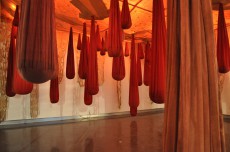
fig.1
Fruits of Labour (A Monument to Exhaustion)
Exhibition at Zhejiang Art Museum, 2013.

Primal Reminders (The Precarious Balance)
wood, burlap, wool, iron, paper, size variable, 2017.
photo: YAMAMOTO Tadasu



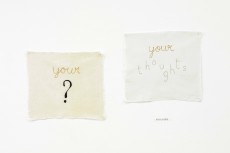
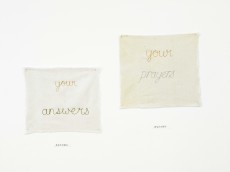
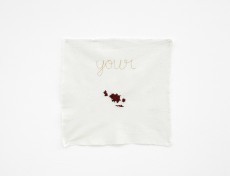
Primal Reminders (Our Bodies)
Hand embroidery on calico cotton, setting pins, size variable, 2017.
photo: YAMAMOTO Tadasu
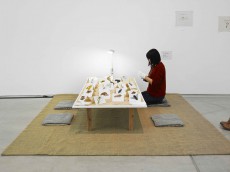
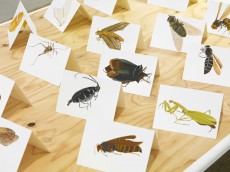
Primal Reminders (Experience of Innocence)
gouache and pencil on acid free paper, wooden reading table, size variable, 2017.
photo: YAMAMOTO Tadasu
